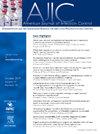Steam quality monitoring as a strategy to reduce wet packs and sterilization failure
IF 3.8
3区 医学
Q2 INFECTIOUS DISEASES
引用次数: 0
Abstract
Background
Hospital articles processed by steam are widely used in the Central Sterile Supply Department (CSSD), responsible for due sterilization. Steam sterilization is discussed worldwide, aiming to protect patients. If steam is outside the specified requirements, the sterilization process may fail, resulting in the wet packs at the end of the sterilization cycle.
Methods
The present study evaluated the steam quality at Santa Catarina Hospital (São Paulo, SP, Brazil) from 2016 to 2022. Saturated steam containing noncondensable gases, excess condensate, or even superheat was characterized using the methodology indicated in the European Standard EN 285:2015.
Results
From 2016 to 2020, qualification tests showed that the saturated steam quality does not achieve standard limit parameters. Infrastructural maintenance actions were taken to adjust the saturated steam quality. In 2021, the steam quality followed technical standards, and its adequacy was confirmed in 2022.
Conclusions
The points developed by the hospital's maintenance department, the adoption of appropriate devices for this purpose, and the correct preventive maintenance in the autoclaves, together with the correct qualification of the equipment and proof of the steam quality, contributed to improve the safety of the hospital sterilization process and reduce the incidence of wet packages.
将蒸汽质量监测作为减少湿包和灭菌失败的策略。
背景:中央消毒供应部(CSSD)广泛使用蒸汽处理医院物品,负责清洁、消毒、准备和灭菌。全世界都在讨论蒸汽灭菌,目的是保护病人,而技术规范有助于使整个过程标准化。如果蒸汽不符合规定要求,灭菌过程就可能失败,导致灭菌周期结束时出现湿包:本研究评估了圣卡塔琳娜医院(巴西圣保罗)2016年至2022年的蒸汽质量。采用欧洲标准EN285:2015中规定的方法,对含有不凝性气体、过量冷凝水甚至过热度的饱和蒸汽进行了鉴定:从 2016 年到 2020 年,鉴定测试表明,饱和蒸汽质量未达到不凝性气体和干燥度值的标准限制参数。为调整饱和蒸汽质量,采取了基础设施维护行动。2021 年,蒸汽质量符合技术标准,2022 年,蒸汽质量得到确认:结论:医院维护部门根据相关技术指南制定的要点、为此目的采用的适当设备、高压灭菌器的正确预防性维护,以及设备的正确合格性和蒸汽质量证明,有助于提高医院灭菌过程的安全性并减少湿包裹的发生。
本文章由计算机程序翻译,如有差异,请以英文原文为准。
求助全文
约1分钟内获得全文
求助全文
来源期刊
CiteScore
7.40
自引率
4.10%
发文量
479
审稿时长
24 days
期刊介绍:
AJIC covers key topics and issues in infection control and epidemiology. Infection control professionals, including physicians, nurses, and epidemiologists, rely on AJIC for peer-reviewed articles covering clinical topics as well as original research. As the official publication of the Association for Professionals in Infection Control and Epidemiology (APIC)

 求助内容:
求助内容: 应助结果提醒方式:
应助结果提醒方式:


